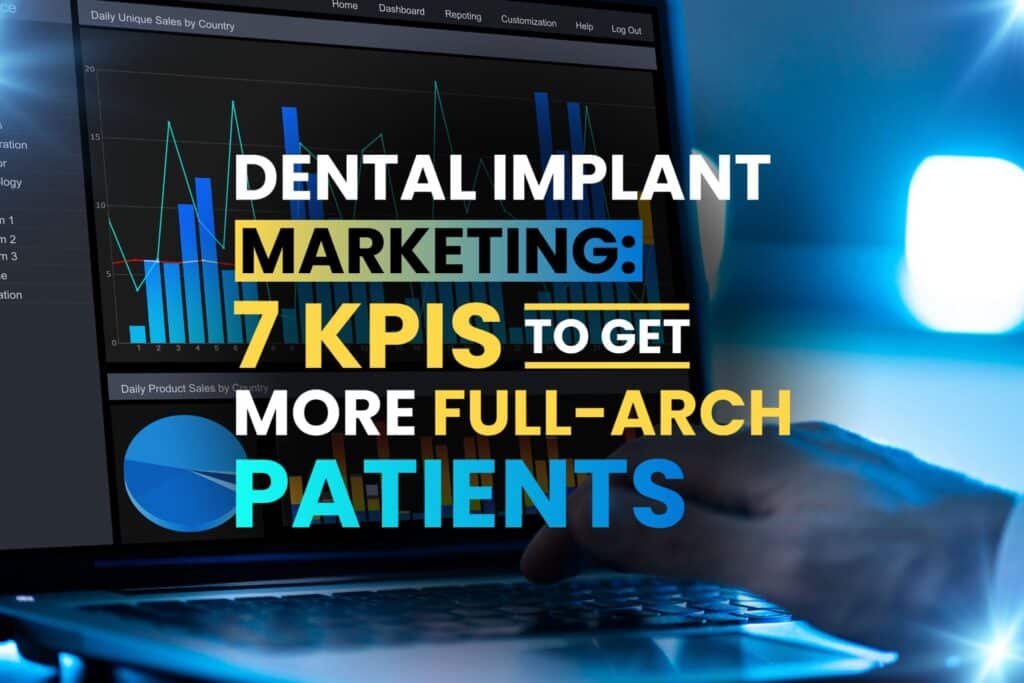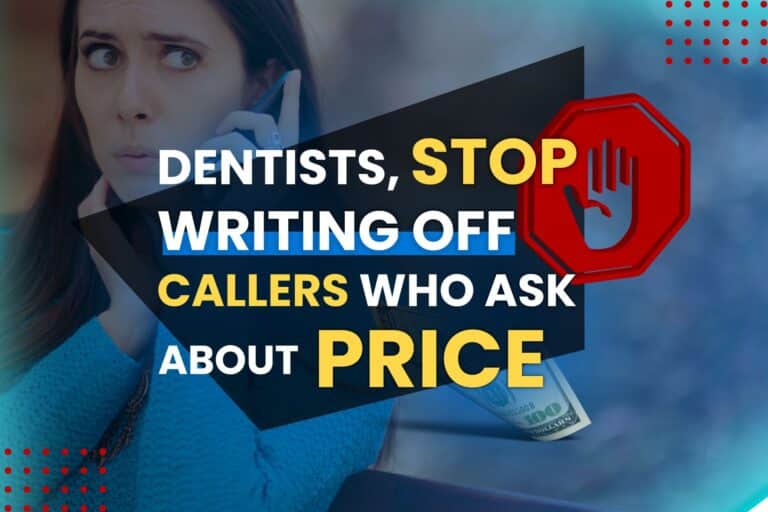Good marketing is the key to implant or full-arch new patient growth. Whether you’re running a dental implant center or just looking to do more full-arch treatment at your GP practice, you need a clear, cohesive marketing strategy in order to get predictable results.
But once you’ve got that strategy in place, how do you track what’s working and what isn’t? Yeah, you want to know how many leads and starts you’re getting, but without more context, those numbers offer a misleading picture of your overall marketing performance.
If you want to really assess your implant marketing pipeline, you need to measure 7 key KPIs. These offer a high-level, end-to-end snapshot of how you’re doing.
The 7 key implant marketing KPIs
Here are the top KPIs for implant/full-arch marketing:
- Number of leads
- Contact rate
- Qualified lead rate
- Qualified lead schedule rate
- Show rate
- Qualified consult rate
- Start rate
Let’s go through each one in order.
Number of leads
This number can be misleading on its own. Tracking the raw number of leads you get each month doesn’t account for lead quality — or for operational barriers that could be blocking conversion and case acceptance.
But that doesn’t mean it’s not important. Your number of leads is the starting point that you can then use to assess the quality of your leads, your conversion efforts, and how well you’re doing actually closing cases in the room.
If your monthly leads number is lower than you’d like it to be, that means that you’re likely either:
- Marketing to the wrong audience
- Investing too little
- Making it too complicated for ad viewers to request more info
Contact rate
Here’s where things get interesting. 60 to 70 percent of implant leads come through contact forms — and if you want to start the process of turning those leads into consults, you’ve got to call them back right away.
Enter contact rate. This KPI measures how many of your leads your team is able to speak with on the phone. This needs to happen quickly — minutes are better than hours and hours are better than days — so that you can engage with each lead while their level of energy and excitement is high.
Target contact rate: 50 percent.
If your contact rate is significantly below 50 percent, then you should investigate these three common problem areas:
- Taking too long to contact your leads
- Getting too many bot sign-ups
- Not making it clear to your leads that they’re filling out a contact form
Qualified lead rate
Qualified lead rate goes hand-in-hand with contact rate. One of the key reasons to get your leads on the phone ASAP is so you can qualify them — figure out whether they are a good fit for your services.
Here are three basic qualifying factors for implant or full-arch leads:
- Are they a candidate for your services? If you only do full arch, then someone looking for a cleaning or even a single tooth implant would be disqualified.
- Are they in range of your practice? While full-arch patients, especially, tend to be more willing to travel than those seeking regular dental care, a lead is far more likely to be serious if they’re local.
- Can they afford treatment? Some practices do all of this during a consult, but many at least start the process over the phone. Consider exploring factors like credit score, access to a co-signer or financing, or ability to make a down payment — or simply offering a ballpark price range for treatment to help leads assess whether or not moving forward is financially possible.
Target qualified lead rate: 50 percent.
If your qualified lead rate is much below that target number, then you’re probably advertising to the wrong audience.
Schedule rate for qualified leads
Lots of practices already track some form of schedule rate. But… if you don’t look at this number in the context of your contact rate and your qualified lead rate, then it’s meaningless.
Here’s what we mean. Let’s say your data says that you have a 20 percent schedule rate. That sounds terrible, right?
Not so fast. You shouldn’t care about the percentage of leads that you schedule. You should only care about the percentage of qualified leads that you schedule — and as we’ve already established, that’s going to be a small fraction of your total number of leads.
In other words, it doesn’t matter if you’re scheduling 20 percent of your overall leads as long as you’re scheduling 90 percent of your qualified leads.
Target schedule rate for qualified leads: 80 to 90 percent.
If you’re not hitting your target rate, it points to either a problem with your offer (your new patient consult should be free) or issues with your phone scripting.
Show rate
Once you schedule a qualified lead for a free consult, how often do they actually show up? Not as often as you’d think.
Show rates for full arch or implants are low compared to GP. But that’s because we’re dealing with a different market here.
Target show rate: 60 percent.
If you have a hyper-efficient scheduling process with lots of open schedule blocks so you can get people in within a day or two, you can probably push this number to between 70 and 80 percent. Conversely, if it takes more than 3 business days to get somebody in, you can expect your show rate to fall.
Qualified consult rate
Your qualified lead rate helps you track the percentage of leads who show up for a consult who are both able to afford treatment and are clinically suitable (i.e., not disqualified for something like insufficient bone density).
Now if you’re doing at least some financial qualifying over the phone (reflected in your qualified lead rate), then this rate should be really high. If it isn’t, then you should consider refining the earlier steps of your marketing funnel to help identify disqualified leads earlier in the process.
Ideally, your only major source of disqualifications at this point is going to be clinical.
Target qualified consult rate: 80 to 90 percent.
Start rate
Your start rate is really simple to calculate. How many of your consults become starts?
However, achieving a healthy start rate is essential because this is where the rubber meets the road. Your start rate determines your ROI for your entire funnel.
A low start rate means that you’re paying more in acquisition costs for each new patient. Conversely, raising your start rate will cut your per-patient marketing costs substantially (doubling your start rate means that you’ve slashed your cost to acquire each patient in half).
Target start rate: 30 percent.
If your start rate is below where you want it to be, you need to go back through the previous six KPIs and figure out where the bottlenecks are.
You should also take a look at your sales process once a patient is in the room. For example, are you focusing your pitch on how you can improve a patient’s quality of life or getting too caught up describing the implant process?
Also critical: Assess how you’re doing lead nurturing with patients who aren’t quite ready to commit to treatment during your initial consult. Many patients may want to eventually move forward, but can’t or won’t right away — so you’ll want to continue to connect with them on the phone over the next several months to maintain the relationship until they are prepared to start.
How this all fits together
Here’s an example to show how all of these KPIs fit together. Let’s say you generate 100 full-arch leads. We’ll run those leads through this funnel, using the target rates for each KPI.
| Funnel steps | Target conversion rate | Number of leads remaining* |
|---|---|---|
| Number of leads | 100 | |
| Contacts | 50% | 50 |
| Qualified leads | 50% | 25 |
| Scheduled | 80% | 20 |
| Show | 60% | 12 |
| Qualified consults | 90% | 11 |
| Starts | 30% | 3 |
*These are rounded to the nearest whole number.
You can plug your own data into this format to get a clear, high-level picture of how your marketing is performing and where you can improve.
Tracking your KPIs
Your best bet here is to invest in a good CRM (or customer relationship management software). Correctly implemented, a CRM will automatically capture all of your form leads and then allow you to track how each lead progresses through every stage of your funnel from contact to case acceptance.
A CRM will also prove enormously valuable with your lead nurturing efforts for patients who aren’t ready to commit during their initial consult.






